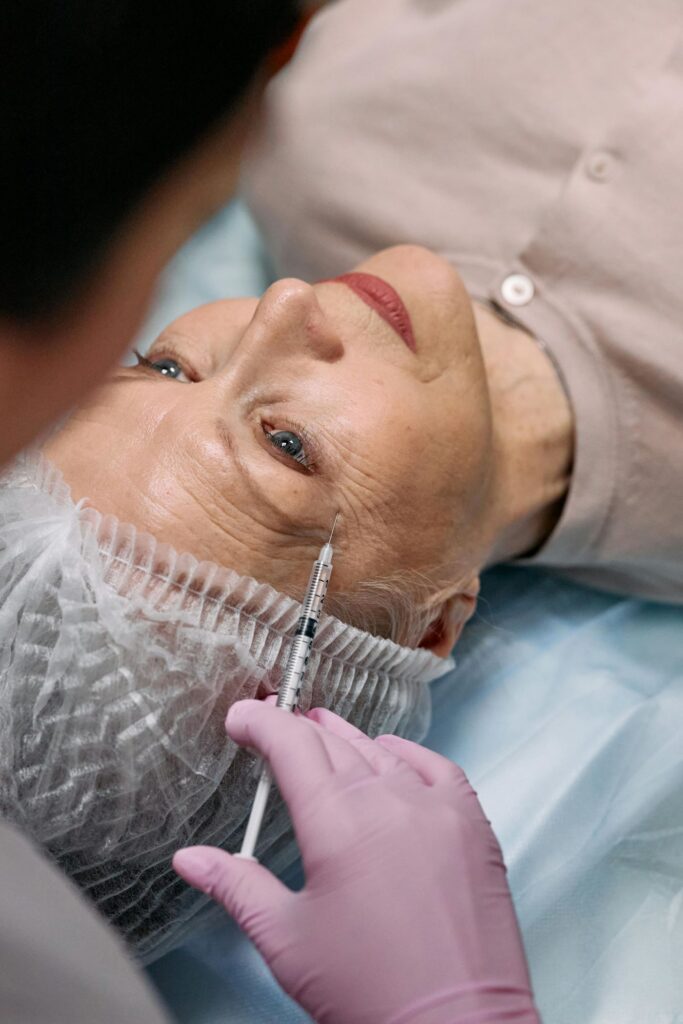No products in the cart.
Skin Care
The Science Behind Anti-Wrinkle Injections
Ever wondered how those seemingly age-defying faces maintain their smooth, wrinkle-free appearance? Enter anti-wrinkle injections, the popular cosmetic procedure that has revolutionized the fight against aging. In this article, we delve into the science behind these injections, exploring how they work their magic to diminish wrinkles and fine lines. From the science of muscle relaxation to the role of neurotransmitters, we uncover the mechanisms that make anti-wrinkle injections a go-to solution for many seeking youthful, rejuvenated skin.

Understanding Anti-Wrinkle Injections
Anti-wrinkle injections are a common cosmetic treatment for reducing the appearance of wrinkles and fine lines on the face. They operate by relaxing the muscles that generate wrinkles, resulting in a smoother, more youthful complexion. Anti-wrinkle injectables come in a variety of forms, including Botox and fillers, and each one works differently to achieve the desired results.
Types of Anti-Wrinkle Injectables
Botox, commonly known as botulinum toxin, is an anti-wrinkle injection that works by inhibiting the nerve signals that cause face muscles to contract. This reduces the appearance of wrinkles and fine lines. Fillers, on the other hand, function by increasing facial volume, which can assist in smoothing wrinkles and fine lines. They are typically formed of hyaluronic acid or collagen.
How They Work
Anti-wrinkle injection work by targeting certain facial muscles that cause wrinkles and fine lines. Botox inhibits the nerve signals that cause these muscles to contract, whereas fillers give volume to the face, which can help smooth out wrinkles and fine lines. Anti-wrinkle injectables usually have a long-lasting impact, and the procedure can be repeated to maintain the desired results.
Areas of Treatment
Anti-wrinkle injectables can be used to treat a wide range of facial locations, including the forehead, eyes, and lips. They can also be used to treat other parts of the body, including the neck and hands. The particular places that can be treated will vary depending on the anti-wrinkle injection used and the intended outcome.
Overall, anti-wrinkle injections are a safe and efficient method for reducing the look of wrinkles and fine lines on the face. They function by focusing on certain muscles and nerve signals, resulting in a smoother, more youthful appearance. To get the finest outcomes, you should engage with a trained and experienced provider.

The Procedure
Initial Consultation
Prior to therapy, an initial consultation with a skilled practitioner is required to review the patient’s expectations and determine their suitability for the process. During the consultation, the practitioner will inspect the patient’s skin and explain the possible treatment options. They will also go over the risks and benefits of the operation and address any questions the patient may have.
During the Treatment
Anti-wrinkle injections entail injecting a small amount of a purified protein solution into the muscles that generate wrinkles. The treatment works by stopping nerves and muscles from contracting, resulting in wrinkles. The treatment is rapid, often taking less than 30 minutes to complete. The practitioner will use a fine needle to inject the fluid into the desired regions. The operation is generally well tolerated, with most patients experiencing minimal to no discomfort.
Post-Treatment Care
Following therapy, patients may suffer slight swelling, bruising, or redness at the injection site. Applying ice wrapped in a towel to the affected area can help reduce swelling. Patients should refrain from rubbing or massaging the treated region and engaging in intense activities until their skin has completely recovered. To avoid dry skin, apply moisturizer throughout the day and wear sunscreen when outside. The recuperation time is often brief, and patients can resume their routine activities soon following treatment.
To summarize, anti-wrinkle injections are a safe and efficient approach to diminish the appearance of wrinkles and achieve a younger appearance. Patients who receive proper consultation, therapy, and post-treatment care can benefit from this non-surgical approach.
Potential Side Effects and Risks
When it comes to anti-wrinkle injections, it is crucial to be aware that the process may have side effects and hazards. While most people have little to no adverse effects, some may develop mild to severe reactions.
Common Side Effects
The most common side effects of anti-wrinkle injections are transient redness, edema, and bruising around the injection site. Some people may have headaches or flu-like symptoms soon after receiving treatment. These side effects typically resolve within a few days and do not necessitate medical treatment.
Serious Complications
While rare, anti-wrinkle injections might cause serious problems. Complications include infection, discomfort, bleeding, itching, discoloration, and even blindness. It is crucial to highlight that these problems are exceedingly rare, occurring in less than 1% of patients.
Allergic reactions are also possible, but they are quite infrequent. If you have any serious symptoms, such as trouble breathing, swelling of the face or throat, or hives, seek medical assistance right once.
It is critical to select a trained and experienced practitioner to do the injections. This reduces the chance of difficulties and ensures that the surgery is carried out safely. If you’re thinking about getting anti-wrinkle injections, talk to your doctor about whether they’re right for you.

Choosing the Right Professional
When it comes to receiving anti-wrinkle injections, selecting the correct specialist is critical. The following are some considerations to consider while choosing a qualified practitioner.
Qualifications to Look For
It is critical to find a practitioner with the necessary skills and expertise. Look for someone who is a board-certified dermatologist or plastic surgeon. These professionals have received the requisite training and experience to properly and successfully give anti-wrinkle injections.
Questions to Ask
Before obtaining anti-wrinkle injections, make sure you ask the proper questions during your initial visit. Here are some key questions to ask:
- What is your personal experience with anti-wrinkle injections?
- Can you provide before and after photos of previous patients?
- What are the possible dangers and adverse effects of the procedure?
- Which types of anti-wrinkle injections do you use?
- How long do the results usually last?
- How much does the surgery cost?
- Does insurance cover the cost of anti-wrinkle injections?
Asking these questions can help you better understand the technique as well as the practitioner’s qualifications and experience. During the meeting, you should also reveal any medical history or medications that you are now taking. This will ensure that the practitioner can deliver the most appropriate treatment for your specific needs.
In conclusion, selecting the correct professional is critical when it comes to anti-wrinkle injections. Looking for a trained practitioner and asking the proper questions during the consultation will help you secure a safe and effective therapy.
Conclusion
Finally, anti-wrinkle injections are successful because they target the underlying source of facial wrinkles: muscle contractions and repetitive facial expressions. These injections smooth down the skin’s surface by temporarily relaxing the underlying muscles, resulting in fewer wrinkles and fine lines. While they produce impressive effects, it is critical to approach such cosmetic treatments with prudence and under the supervision of trained experts. Understanding the science behind anti-wrinkle injections enables people to make informed decisions about their skincare journey, resulting in safe and fulfilling outcomes in the pursuit of timeless beauty.
Trusted Health, Wellness, and Medical advice for your well-being



Recommended Posts
The Fascinating Process of Sesame Oil Making
Sesame oil, recognized for its rich flavor, nutritional benefits, and versatility in culinary applications, has
Does Mouth Taping Increase Nitric Oxide
If you’re seeking for a natural way to boost your sports performance or overall health,
Discover the Best Exercises to Strengthen Your Pelvic Floor Today
Looking to strengthen your pelvic floor but unsure which exercises to include in your routine?
What Is Exercise Therapy
Exercise therapy is a type of physical therapy that uses particular motions to improve body
What is Stroke Level Blood Pressure?
Maintaining normal blood pressure is critical for general health. Normal blood pressure is usually around
The Ultimate Guide to Black Friday Grocery Shopping
As grocery shops and supermarkets all throughout the country launch their largest sales of the